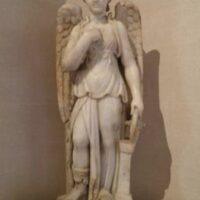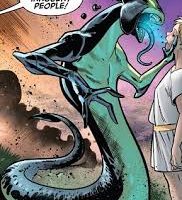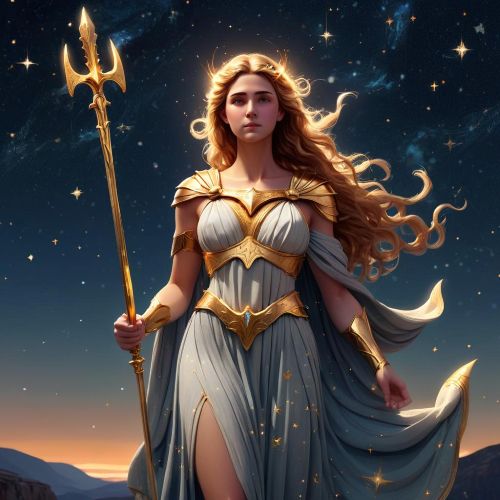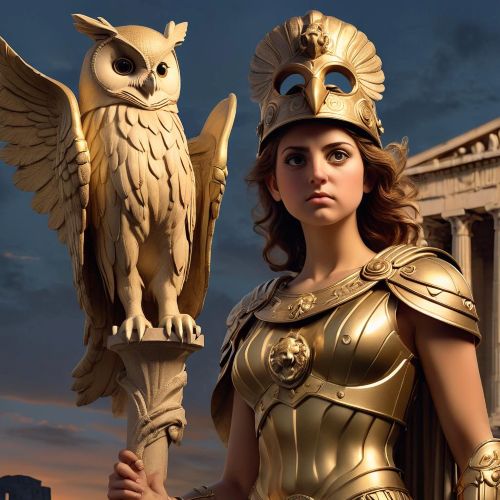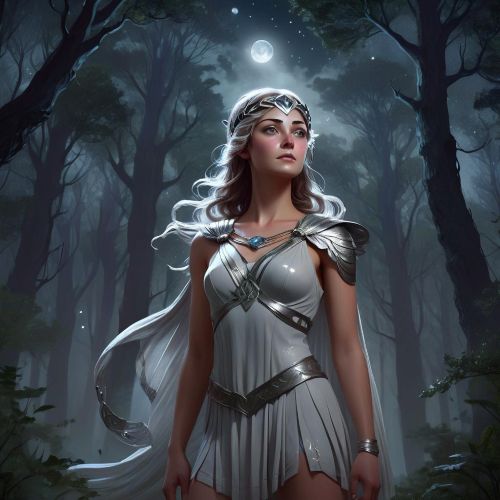Oizys : Goddess of Depression
Listen
At a glance
| Description | |
|---|---|
| Origin | Greek Mythology |
| Classification | Gods |
| Family Members | Nyx (Mother), Moros, Thanatos, Hypnos, Eris, Geras and Apate (Siblings) |
| Region | Greece |
| Associated With | Misery, Depression |
Oizys
Introduction
Introduction
In the vast realm of Greek mythology, where deities embody nearly every aspect of existence, Oizys stands as the haunting personification of misery and suffering. Known in Greek as Ὀϊζύς and in Roman tradition as Miseria, she represents anguish, woe, and distress in their purest forms. Unlike the Olympian gods who rule over tangible realms such as the sea, the sky, or war, Oizys exists as a force that shapes the emotional and psychological state of mortals. Her presence is not found in grand myths of heroism but instead woven into the sorrowful undercurrents of human life, reminding ancient audiences that anguish was not only an unavoidable part of existence but also a divine power in its own right. Through her, the Greeks acknowledged the inevitability of pain and the shadow it casts across human experience.
Physical Traits
Unlike gods such as Zeus or Athena, who appear frequently in sculpture and literature, Oizys remains elusive in visual representation. Ancient texts provide no specific details of her form, suggesting that she was perceived more as an abstract force than as a deity with a recognizable body. However, later interpretations and artistic imaginations attempt to visualize her essence. She is often imagined as a pale, shadowy woman cloaked in tattered garments, her figure shrouded in veils that symbolize sorrow and concealment. Artists sometimes depict her eyes as hollow or downcast, conveying despair without words. Surrounding her, artists may add mist, rain, or dim light to embody the gloom she represents. This lack of definitive description aligns with her nature as a psychological presence rather than a mythological character with stories of action or battle. Oizys was never meant to be seen as a physical being; she was meant to be felt.
Family
Oizys belongs to the shadowy brood of Nyx, the goddess of Night, who alone birthed a host of primordial deities that personified the darker elements of life. In Hesiod’s Theogony, Oizys emerges as one of Nyx’s many children, born without a father. Her siblings include Moros (Doom), Thanatos (Death), Hypnos (Sleep), Eris (Strife), Geras (Old Age), Apate (Deceit), and Nemesis (Retribution). Each sibling reflects another inevitability of mortal existence, forming a pantheon of dread that underscores the inescapability of suffering. Some later traditions suggest she was the twin of Momus, the spirit of blame, linking misery closely with criticism and judgment. Other accounts, though less prominent, describe her as a child of Zeus and Hera, placing her among the Olympians as a sister of Ares. This alternative genealogy reflects the fluidity of myth, but the most enduring and widely accepted account ties her directly to Nyx, situating her within a family of personifications rather than Olympian rulers.
Other names
The name “Oizys” itself carries weight, derived from the Greek root for misery and distress. In Roman tradition, she was known as Miseria, a term that carried over directly into modern European languages and eventually into English as “misery.” This linguistic continuity highlights her lasting influence beyond myth into everyday speech. Unlike other deities who collected numerous epithets or regional titles, Oizys remained singular in her identity. Her name alone sufficed to encapsulate the depth of her domain. Where gods like Apollo had countless bynames reflecting different aspects of their worship, Oizys’s identity was unwavering: she was misery itself, and her name needed no embellishment.
Powers and Abilities
Oizys’s powers are not displayed in heroic tales or epic battles but instead manifest in the emotional world. She is the embodiment of grief, hopelessness, and despair, and her influence touches both mortals and immortals. Unlike Olympians whose powers were external—controlling seas, storms, or flames—Oizys governed the inner landscape of the soul. Ancient Greeks may have understood her presence in moments of mourning, in prolonged anxiety, or in the weight of depression. Some mythographers suggest that, as a daimon, her influence could envelop spaces, casting a pall of gloom over communities just as easily as it could settle into an individual heart. Later mythological interpretations attribute to her subtle abilities, such as controlling tears or manifesting her aura in the form of shadows and stillness. She is sometimes imagined as capable of giving her descendants black wings, linking her to other dark daimones who traversed between the realms of gods and mortals. Yet her most profound power lay not in spectacle but in inevitability—she was misery personified, and her strength was inescapable.
Modern Day Influence
Though not as widely recognized as Olympians like Zeus or Athena, Oizys continues to resonate in the modern imagination. Her Roman name, Miseria, directly influenced the English word “misery,” ensuring that her legacy survives linguistically every time the word is used. In psychology, her domain connects with discussions of melancholia, depression, and existential dread. Thinkers in philosophy and literature often invoke her as a metaphor for the universal nature of suffering. In modern literature, she sometimes appears in reimagined mythologies, serving as a symbol of despair or as a figure embodying the struggles of mental illness.
Digital artists and writers inspired by myth frequently depict Oizys in visual art and creative works, portraying her as a veiled woman, a spectral shadow, or even as a tragic anti-heroine in myth-inspired storytelling. In video games and graphic novels, she occasionally surfaces as a background force—never a central combatant but a reminder of emotional battles within the story. In academic circles, Oizys’s association with psychological affliction has made her a reference point in studies that bridge ancient myth with modern understandings of mental health.
Her continued relevance reflects how ancient myths endure, not only through stories of triumph but also through recognition of universal truths. By personifying misery, the Greeks externalized one of the most intimate human struggles, and in doing so, they gave future generations a language for sorrow that remains poignant even today.
Related Images
Source
Hesiod. (2006). Theogony and Works and Days (M. L. West, Trans.). Oxford University Press. (Original work published ca. 700 BCE)
Grimal, P. (1996). The Dictionary of Classical Mythology (S. Kershaw, Trans.). Blackwell Publishing.
Hard, R. (2004). The Routledge Handbook of Greek Mythology. Routledge.
Morford, M., Lenardon, R. J., & Sham, M. (2018). Classical Mythology (11th ed.). Oxford University Press.
Oizys – Goddess of Grief, Anxiety, and Depression. (2022). https://greekgodsandgoddesses.net/goddesses/oizys/
Oizys | Encyclopedia of myths Wiki. (2008). https://encyclopediaofmyths.fandom.com/wiki/Oizys
Alilia Athena. (2024). Myths of Divine Regret – Oizys. https://paleothea.com/gods-and-goddesses/myths-of-divine-regret/
Frequently Asked Questions
What is lorem Ipsum?
I am text block. Click edit button to change this text. Lorem ipsum dolor sit amet, consectetur adipiscing elit. Ut elit tellus, luctus nec ullamcorper mattis, pulvinar dapibus leo.
What is lorem Ipsum?
I am text block. Click edit button to change this text. Lorem ipsum dolor sit amet, consectetur adipiscing elit. Ut elit tellus, luctus nec ullamcorper mattis, pulvinar dapibus leo.
What is lorem Ipsum?
I am text block. Click edit button to change this text. Lorem ipsum dolor sit amet, consectetur adipiscing elit. Ut elit tellus, luctus nec ullamcorper mattis, pulvinar dapibus leo.
What is lorem Ipsum?
I am text block. Click edit button to change this text. Lorem ipsum dolor sit amet, consectetur adipiscing elit. Ut elit tellus, luctus nec ullamcorper mattis, pulvinar dapibus leo.
What is lorem Ipsum?
I am text block. Click edit button to change this text. Lorem ipsum dolor sit amet, consectetur adipiscing elit. Ut elit tellus, luctus nec ullamcorper mattis, pulvinar dapibus leo.




